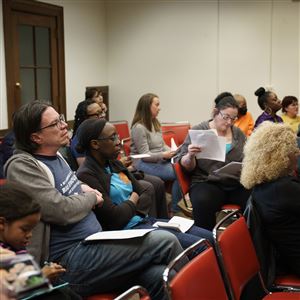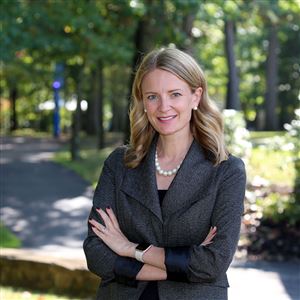After Saniya Jones wraps up her shift at Once Upon A Child in Robinson on Mondays, the 11th grader typically finds herself surrounded by friends, either lacing up their ice skates or sitting down at their favorite restaurant.
Unlike other 16-year-olds, Saniya, a City Charter High School student, has Mondays off after the Downtown school in 2021 moved to a four-day week for students and teachers. Now, she takes full advantage of the day to make extra money, catch up on school work and see her friends.
“It makes it easier to get through the week,” Saniya, of Sheraden, said. “Because as soon as Tuesday and Wednesday are over it’s just like get through Thursday, get through that last eight hour school day on Friday and then we’re done for three days.”
City Charter is one of a handful of Pennsylvania schools that have implemented a four-day week, part of a growing trend across the country as districts continue to grapple with teacher shortages and other pandemic-related impacts.
In Pennsylvania, schools taking advantage of the schedule seem to be charter and private schools. Those schools have long been able to meet the requirements of 180 school days or 900 school hours for elementary students and 990 for secondary students.
Few, if any, traditional public schools have made the move even after legislation was signed in December 2023 amending the Pennsylvania School Code. Previously traditional school districts had to meet a requirement of 180 school days. Unlike charter and private schools, districts did not have the option of meeting an hourly requirement. But the 2023 amendment now permits districts to meet 180 days or the set number of hours, giving more flexibility to weekly school schedules.
According to Paul Thompson, an economics professor at Oregon State University who studies four-day school weeks, the trend largely started in states west of the Mississippi River where many school districts have large geographic boundaries. But that continued to grow in the mid-2000s through the Great Recession as a way to save money. And in the years following the pandemic, schools have continued jumping on board to help alleviate teacher stress and burnout.
Today, Mr. Thompson said, more than 900 districts nationwide operate on a four-day week.
But while Mr. Thompson pointed to families, students and teachers being satisfied with the schedule, he noted there are several challenges that go along with it.
“The four-day school week has these much larger ramifications for students and families,” Mr. Thompson said. “So thinking about, what does this mean for nutrition or physical activity? What does this mean for how families function and whether parents can work?”
He also pointed to financial savings and student achievement.
Districts that have made the switch have only saved up to 2% of their expenditures. Still, many districts said after COVID that any bit of financial flexibility “can be beneficial,” Mr. Thompson said. Student achievement, on the other hand, has remained relatively steady between a five-day and four-day model as long as schools maintain instructional time.
Local changes
Instructional time was a key piece for officials at Bishop McCort Catholic High School in Johnstown, which moved to a four-day week two years ago. At the time, start times shifted from 8 a.m. to 7:40 a.m. And students stay until 3:05 p.m. rather than 2:25 p.m.
The idea, Principal Tom Smith said, started as the school was grappling with a teacher shortage. At the time, Mr. Smith spoke to 20 districts in Texas — today 114 districts in Texas have a four-day week, the TV station KXAN reported — all of which said “they would never go back” to a five-day schedule.
After seeing the positive reviews, and that some teachers were willing to take a lower paying job for the four-day week, Mr. Smith presented the idea to the school board.
It was implemented six months later.
Today, seventh through 12th graders at the high school follow the four-day week. Kindergarten through sixth graders still follow a five-day week.
Since its implementation there have been many positive impacts, Mr. Smith said, including improved absenteeism rates and test scores. And teacher and staff morale has also increased.
“When you're working four days a week, it goes really fast,” Mr. Smith said. “It goes really fast. And … it has been great for morale in our school, for our staff and for our student population.”
Officials at California Area School District in Washington County this school year have also taken steps to boost teacher morale. While students still attend classes five days a week, teachers spend four days in school. The fifth day is a prep day, which can be done from home. Teachers alternate which day of the week is their prep day to ensure classes are still covered.
“They don’t have to be on campus, they don’t have to be in for meetings or anything like that,” Superintendent Laura Jacob said. “If they have to do a doctor’s appointment, if they have to go grocery shopping or do laundry or be home they can do that on their prep day.”
To accommodate the change, several shifts were made to class schedules.
Those shifts, Ms. Jacob said, have largely been well received by students, families and teachers, who approved the changes in their latest union contract.
Under the contract, if the teacher attendance rate falls below 86%, they’ll return to a traditional five-day week. But, according to Ms. Jacob, “my teacher attendance this year is better than I ever had it and I’ve been with the district five years now.”
Despite that success, Ms. Jacob said students will likely not move to a four-day schedule. The district is a small, rural system of 930 students. Of those, 56% are economically disadvantaged and 21% are in special education.
“We’re primarily low-income,” Ms. Jacob said. “My kids have to come in. I need them to be here every day of the week.”
Because of that, working parents rely on California Area for childcare. And over 100 kids stay for afterschool programs, some of which run until 6 p.m. That means those kids are eating breakfast, lunch and dinner at the district. Ms. Jacob is also working to decrease educational gaps, something she needs kids in classrooms to accomplish.
“Giving kids the structure, giving them experiences and having them here in school is beneficial,” Ms. Jacob said. “I think it’s a way to help decrease the opportunity gaps that kids have due to economic status.”
At City Charter High School, officials first started discussing the idea of a four-day school week before the pandemic. The school experimented with the model during COVID and in 2021 it was fully implemented after surveying students, staff and parents. Officials also talked to Colorado districts where more than 60% operate on a four-day schedule, Colorado Public Radio reported.
For City Charter, the idea came as school officials were looking to alleviate teacher and student burnout. City Charter follows a rigorous trimester schedule, meaning students attend school year-round. Under that schedule they’ll take classes for three months before having one month off. And they have longer days, attending class from 8 a.m. until 3:45 p.m.
“Since 2002 we had been doing that five days a week,” Tiana DeLaRosa, principal on special assignment, said. “And so that is a really long school day. It’s a lot on the students, it was a lot on teachers. … People weren’t finding that balance.”
Today, students and teachers have Mondays off.
Once a month they’ll open the school on a Monday to allow students to participate in optional activities such as kayaking and Super Smash Bros. competitions.
For financial literacy teacher Perry Harrop, the change has made everything compressed, meaning teachers have to get content in “very quickly.” But it also has benefits.
Teachers use the day to help them prepare for the work week. Mr. Harrop often uses Monday morning to catch up on work. But by the afternoon he’s able to shift his focus to his personal life.
Parent Autumn Stevens also approves of the system. Ms. Stevens, who works fulltime, drives her daughter, Kalena Richardson, a City Charter 10th grader, to school each day. But on Mondays, Ms. Stevens, of Wilkinsburg, has a little more time to herself.
“I've noticed, and what she has noticed herself, is she feels more rested,” Ms. Richardson, of Wilkinsburg, said. “She has Monday to relax and just prep everything for the week, talk to her friends or go out. It's really been beneficial.”
Matthew Stevenson, a 16-year-old 10th grader, agreed.
“Having a free Monday, it helps me be more energized and ready more for school,” Matthew said. “I can spend my Monday working, I can spend it with my family. It just feels better than the normal two day weekend.”
First Published: March 24, 2025, 8:00 a.m.
Updated: March 25, 2025, 1:27 p.m.























